Posts Tagged ‘Antarctica’
» posted on Thursday, December 24th, 2020 by Linda Lou Burton
Christmas Eve with Evie
Christmas in Antarctica originally posted by Linda Lou Burton December 24, 2005 from Arctowski Station, Admiralty Bay, King George Island, Antarctica – Today is Christmas Eve, and I have walked Antarctic soil. The first announcement on the information speaker at 7:30 was this: “I will no longer comment on the weather. This is silly!” Our expedition leader was awed by our good fortune – clear skies, calm waters, 41 degrees.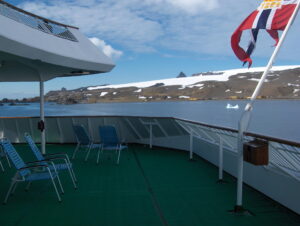
At breakfast, I asked the question. Surely I won’t need my longjohns? Surely not the wool sweater? “Da wetter kud change,” Will admonished me. “Take da swetter!” I was sitting at the table with Will and Paul and Annemarie and their parents, who were chatting away in Dutch with an occasional English comment thrown in for me. I asked Paul what a typical Dutch breakfast would be. He pointed to examples in his plate as he explained it would be sandwich-like, with ham and cheese and vegetables. “What about cereal?” I inquired. “Yes, corn flakes, with sugar already on.” “Frosty flakes?” I said. “Yes!” he laughed. “And chocolate too,” threw in Annemarie. “Cocoa puffs?” I replied. “Yes! Cocoa puffs and chocolate milk!”
 I finished my omelet and sausages, said goodbye, and headed for my room. Time to waterproof. Long underwear, check. Fleece pants, check. Wool socks, check. Wool sweater, check. Waterproof pants next, zipping right, zipping left, Velcro at the bottom. Waterproof bag for cameras into the pack. Fleecy hat, scarf, gloves. Waterproof mittens. Now I rattled when I walked, screech screech, screech, screech. I could not be a spy.
I finished my omelet and sausages, said goodbye, and headed for my room. Time to waterproof. Long underwear, check. Fleece pants, check. Wool socks, check. Wool sweater, check. Waterproof pants next, zipping right, zipping left, Velcro at the bottom. Waterproof bag for cameras into the pack. Fleecy hat, scarf, gloves. Waterproof mittens. Now I rattled when I walked, screech screech, screech, screech. I could not be a spy.
I headed for Dekk 7 to watch the first group leave. The crew had gone first with supplies — set up with enough water and shelter to keep those on shore safe for 24 hours should a sudden storm arise.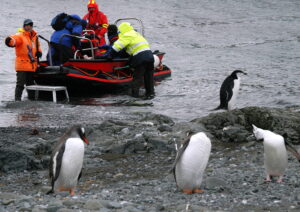
We were divided into six groups, names posted on the wall like a playground list at school. Group 1 is first on the first excursion, followed by Group 2, and so on. Next excursion, Group 2 is first, followed by Group 3, and Group 1 will be last! So, everyone gets a turn to go first. This was explained to us carefully, watching our faces, hoping, I guess, that we wouldn’t be quarrelsome and whiny. I was in Group 6, this was the third excursion for the trip, so, hence, therefore, I would be on the fourth boat today??
“Group 6 may proceed to the Departure Dekk!” was finally called. I scurried down to the boot room, filled with stacks and rows of black rubber Wellies, size clearly handpainted in yellow on the back. I found some 8’s, hoping the fit over the wool socks would work. Puff puff pant pant struggle on with the boots. Into the next room, blop blop blop blop. I was handed a life jacket, helped to adjust it over my Nordic blue Antarctica Voyage of Discovery waterproof, windproof parka. Then fumble through all the layers to find my ID card. Beep, scan me through, officially checked out. Next onto the disinfectant sponge (no germs allowed on shore in the penguin rookery), through the spraywash for the boots, to the ship’s door. Narrow steps, rope for railing, blop blop blop blop to the PolarCirkel boat. I was the last one in.
It was a beautiful ride, five minutes across to Arctowski Base, the hillside above our landing site covered with penguin rookeries. We were not allowed anywhere near the rookeries; our orders were to stick to the path to the Base and allow penguins to come to us.
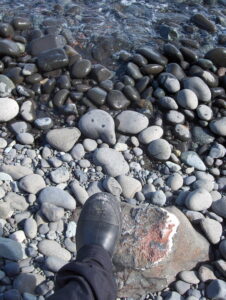 Landing, grab the PolarCirkel rails, step to a metal step perched perilously in the rocky waters. “Jump!” I was told. I jumped, splashed in clear water nearly to my knees. Aha! My well-baptized feet are in the Southern Ocean! But I cannot reach my camera, cannot even walk. A gentleman behind offers his arm. I take it, gratefully, and climb the rocky bank. On shore, I realize I will not be able to walk to the Base, a mile or so away. The rocks are too big, too rough for my uncertain hobble-walk. My feet are slipping inside the Wellies, blop blop blop. I analyze my options.
Landing, grab the PolarCirkel rails, step to a metal step perched perilously in the rocky waters. “Jump!” I was told. I jumped, splashed in clear water nearly to my knees. Aha! My well-baptized feet are in the Southern Ocean! But I cannot reach my camera, cannot even walk. A gentleman behind offers his arm. I take it, gratefully, and climb the rocky bank. On shore, I realize I will not be able to walk to the Base, a mile or so away. The rocks are too big, too rough for my uncertain hobble-walk. My feet are slipping inside the Wellies, blop blop blop. I analyze my options.
“Manuel tells you there are 17 species of penguin,” our leader had said in an earlier briefing, following a lecture by our resident penguin researcher. “But I say there are two. Black penguins, and white penguins. If you see penguins, and run towards them shouting Look Look Penguins!, then you will see nothing but black penguins. If you see penguins, and stand very still, patiently waiting for them to come to you, then you will see white penguins.”
 OK, I decided, as my eyes scanned the rocky shore, I will stand very still. Maybe the penguins will come to me. Patience pays.
OK, I decided, as my eyes scanned the rocky shore, I will stand very still. Maybe the penguins will come to me. Patience pays.
A single penguin came around a rock, hobbling, wobbling, struggling even more than me on the uneven ground. Balancing her flippers sideways, left, right, left, right, she reached the top of our little ridge and looked around. More rocks ahead. An uneven walk to the beach, and lunch.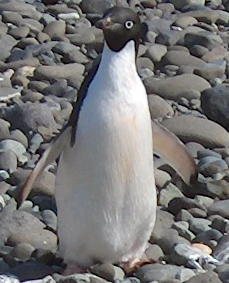
Evie looked up at me. I looked back at Evie. We looked at the hateful rocks together. “ohrmmph” she said, with a shake of her head. “That’s a long walk!”
I knew what she meant. She looked at me again, her white-ringed eyes unblinking and clear. Then she shook her head, flapped her flippers in a get-started motion, and hobbled across the rocks to the ocean shore.
You go, girl.
» posted on Wednesday, December 23rd, 2020 by Linda Lou Burton
Get Ready for Jeopardy!
 Christmas in Antarctica originally posted by Linda Lou Burton December 23, 2005 from Southern Ocean, Antarctica – When I told people I was going to visit Antarctica, responses varied from “Where is that?” to “Why would you want to do something like that?” to “What will you DO there?” to “It will be mighty cold there.” It’s like humor, I guess, if you have to explain it to someone, you know they will never get it anyhow! The people I’m traveling with on this ship are of one mind about Antarctica – they love it, are awed with it, and would come back in a minute.
Christmas in Antarctica originally posted by Linda Lou Burton December 23, 2005 from Southern Ocean, Antarctica – When I told people I was going to visit Antarctica, responses varied from “Where is that?” to “Why would you want to do something like that?” to “What will you DO there?” to “It will be mighty cold there.” It’s like humor, I guess, if you have to explain it to someone, you know they will never get it anyhow! The people I’m traveling with on this ship are of one mind about Antarctica – they love it, are awed with it, and would come back in a minute.
Now you, take a peek at the bottom end of your World Globe, and get your gourd ready for a game of Jeopardy.
Some things to know about Antarctica, AKA, The Ice, gleaned from Alan Parker’s lecture on Antarctica, and my Lonely Planet book. (2020 update: Alan Parker died July 26, 2020. I am pleased I was privileged to hear him speak in 2005.)
- Antarctica has no wars.
- Antarctica’s environment is fully protected.
- Antarctica is a nature reserve devoted to peace and science.
- Antarctica has no native population.
- Antarctica has no native government; no country holds title over any part of it.
- Antarctica is governed by the Antarctic Treaty, with 45 member nations, who meet annually to discuss scientific cooperation, environmental protection, management of tourism, and preservation of historic sites.
- Antarctic residents are temporary; people come to work in Antarctica from dozens of countries.
- Antarctica’s winter population is about 1,200 – one-third scientists and the rest support personnel; summer population is about 7,200.
- Antarctica was visited by over 13,000 tourists in 2003 – 40% from the US, 15% each from Germany and the U. K., 6% from Australia, and 3% each from Japan, Canada and Switzerland.
- Antarctic tourism is controlled by IAATO, International Association of Antarctica Tour Operators, and limits visitors to 100 at any place at any one time.
- Antarctica is the world’s most arid continent.

- Antarctica is the world’s highest continent.
- Antarctica is 99.6% covered by ice.
- Antarctica’s Lambert Glacier is the largest glacier in the world.
- Antarctica’s Ice Sheet is 1.4 times the size of the United States.
- Antarctica’s Ice Sheet contains 70% of the world’s fresh water.
- Antarctica’s ice is so thick, accumulating over millions of years, that its weight pushes the land mass underneath below sea level.
- Antarctica’s Ice Sheet melts very little, even though it has constant sunrays during summer months, because the sun’s heat is reflected back by the ice.
Question please?
» posted on Wednesday, December 23rd, 2020 by Linda Lou Burton
From the Bridge
Christmas in Antarctica originally posted by Linda Lou Burton December 23, 2005 from Drake Passage, Antarctica – We entered the Southern Ocean a few hours ago. AKA the Convergence Zone. The Drake Passage is the Drake Lake today. Sometimes, I’m told, it is the Drake Shake. When that happens, you pay your Drake Tax. I’m wearing my acupressure wristbands to avoid seasickness, even though the roll is gentle. Like the man waving the stick to keep the elephants away, it’s working!
Since there is nothing to look at today but water, water, everywhere, our leader has planned events to keep us busy. Morning, a trip to the Bridge. Then, lectures.
- Penguins: The brush-tailed – Life and Death Part II, by Dr Manuel Marin
- The Antarctic Frigid Zone – Why is it so?, by Alan Parker
- Heroic Hearts: Amundsen and Scott, by Ian Shaw
And of course, our Pre-landing briefing at 6 PM.
The Happy Hour drink today is Planter’s Punch, and the phrase of the day is “Are you cold? Er du kald? Ist Dir kalt? Tienes frio?”
I want to hear Alan Parker’s lecture today. Alan has made 56 trips to Antarctica, been awarded a Polar Medal for his contributions to science in Antarctica, and even has a mountain named for him! Parker Peak. A native of Australia, he has lived on Macquarrie Island for a 12-month stint, and worked at Davis Station for fifteen. Who better to listen to for learning more about Antarctica?
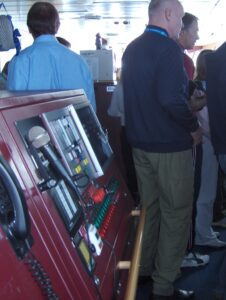 But about the water now: according to my handout, the Antarctic Convergence is where the warmer waters of the north meet the colder, denser, less saline waters of the south. Colder water sinks, of course, causing an up-welling that brings nutrients to the surface. This point, which is ever-changing, is the biological limit of the Antarctic ecosystem. There is no way to know when you cross it except by thermometer. But, I am assured by the second-in-command on the Bridge, we have passed it now. Our Captain is busy shaking hands, greeting visitors, smiling at us all.
But about the water now: according to my handout, the Antarctic Convergence is where the warmer waters of the north meet the colder, denser, less saline waters of the south. Colder water sinks, of course, causing an up-welling that brings nutrients to the surface. This point, which is ever-changing, is the biological limit of the Antarctic ecosystem. There is no way to know when you cross it except by thermometer. But, I am assured by the second-in-command on the Bridge, we have passed it now. Our Captain is busy shaking hands, greeting visitors, smiling at us all.
More facts. The Convergence Zone, this Polar Front, is a function of the Antarctic Circumpolar Current. The waters of Antarctica circle the continent in the world’s biggest ocean current at an estimated rate of 150 million cubic meters per second! That’s  equivalent to FOUR GULF STREAMS or ONE THOUSAND AMAZON RIVERS! As this dense water begins to move north, it has tremendous impact on global weather systems. Carried into the Atlantic and Pacific Oceans, it has a cooling effect on tropical and temperate waters, very important to the oceans’ balance.
equivalent to FOUR GULF STREAMS or ONE THOUSAND AMAZON RIVERS! As this dense water begins to move north, it has tremendous impact on global weather systems. Carried into the Atlantic and Pacific Oceans, it has a cooling effect on tropical and temperate waters, very important to the oceans’ balance.
I’m impressed! “Exactly where is it considered the point where the Atlantic and Pacific meet?” I asked. A shrug. “I don’t know,” was the reply, “perhaps at Cape Horn?”
This is humorous to me. I picture the ship pointed south from Cabos de Hornos, riding a fine dotted line with Atlantic left, Pacific right, then, blip, another hop into Southern Ocean waters.
» posted on Sunday, December 13th, 2020 by Linda Lou Burton
I Wish I’d Brought the Piano
 Christmas in Antarctica originally posted by Linda Lou Burton December 13, 2005 from Seattle, Washington, United States – Overheard in line waiting to get into the theater for a play that has been long sold out:
Christmas in Antarctica originally posted by Linda Lou Burton December 13, 2005 from Seattle, Washington, United States – Overheard in line waiting to get into the theater for a play that has been long sold out:
- Husband: Gee, I wish I’d brought the piano.
- Wife: Oh, you’d play for us while we wait?
- Husband: No, I left the tickets on top of it.
Well folks, I’m checking the top of the piano right now: passport, check; plane tickets, check; cameras and batteries and memory cards and backup this and backup that, check, check, check. Fancy-schmancy luggage sitting by the door.
I’m spending CHRISTMAS in Antarctica!
Had the family over Sunday, talked to the ones far away, spent the afternoon getting a pedicure, can I get any more relaxed? Housesitter coming, backups ready-when-needed, mail on hold, weather clear and cold, looks like a full moon or nearly. Next time you hear from me I’ll be south of the equator. Everything is dang nigh perfect.
Oops, Alex T Cat just barfed all over the carpet.
» posted on Friday, September 8th, 2017 by Linda Lou Burton
A Bi-Polar Year: From the Arctic Circle to Antarctica
A Bi-Polar Year: From the Arctic Circle to Antarctica will be released in 2018.
Here’s a peek at the intro.
It’s something I wanted to do for years. That is, to be north of the Arctic Circle on the first day of summer (June of course), and then to be south of the Antarctic Circle on the first day of summer in the southern hemisphere (December). This had to happen in the same year, I thought. And so it did.
The trip began in June, an easy ride from Seattle to Alaska and the northernmost point in North America. Point Barrow, polar bear country! Then life wound through summer, and autumn, and family, and friends, till I boarded a plane for my flight to Santiago, Chile, and my southbound ship that got me to Cape Horn on December 22. We crossed the Drake Passage in time for Christmas on the White Continent, where I met my first penguin.
Join me?
(c) Linda Lou Burton 2017
» posted on Saturday, April 7th, 2012 by Linda Lou Burton
Conversation on a Bench
Linda Burton posting from Sacramento, California – “It was on my Bucket List,” Jo-Ellen answered to my question. “That’s why I’m here today. There were things to do at home but then I told myself ‘This stuff will still be here tomorrow. The Promenade is now.’ So here I am.” I nodded, completely understanding what she meant.

